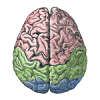1.4: Emergent Phenomena
- Page ID
- 12559
What makes something a satisfying scientific explanation? A satisfying answer is that you can explain a seemingly complex phenomenon in terms of simpler underlying mechanisms, that interact in specific ways. The classic scientific process of reductionism plays a critical role here, where the complex system is reduced to simpler parts. However, one also needs to go in the opposite, oft-neglected direction, reconstructionism, where the complex system is actually reconstructed from these simpler parts. Often the only way to practically achieve this reconstruction is through computational modeling. The result is an attempt to capture the essence of emergence.

Emergence is about interactions between parts. Computer models can capture many complex interactions and reveal nonobvious kinds of emergence.Emergence can be illustrated in a very simple physical system, two interacting gears, as shown in Figure 1.1. It is not mysterious or magical. On the
other hand, it really is. You can make the gears out of any kind of sufficiently hard material, and they will still work. There might be subtle factors like friction and durability that vary. But over a wide range, it doesn't matter what the gears are made from. Thus, there is a level of transcendence that occurs with emergence, where the behavior of the more complex interacting system does not depend on many of the detailed properties of the lower level parts. In effect, the interaction itself is what matters, and the parts are mere place holders. Of course, they have to be there, and meet some basic criteria, but they are nevertheless replaceable.
Taking this example into the domain of interest here, does this mean that we can switch out our biological neurons for artificial ones, and everything should still function the same, as long as we capture the essential interactions in the right way? Some of us believe this to be the case, and that when we finally manage to put enough neurons in the right configuration into a big computer simulation, the resulting brain will support consciousness and everything else, just like the ones in our own heads. One interesting further question arises: how important are all the interactions between our physical bodies and the physical environment? There is good reason to believe that this is critical. Thus, we'll have to put this brain in a robot. Or perhaps more challengingly, in a virtual environment in a virtual reality, still stuck inside the computer. It will be fascinating to ponder this question on your journey through the simulated brain...


